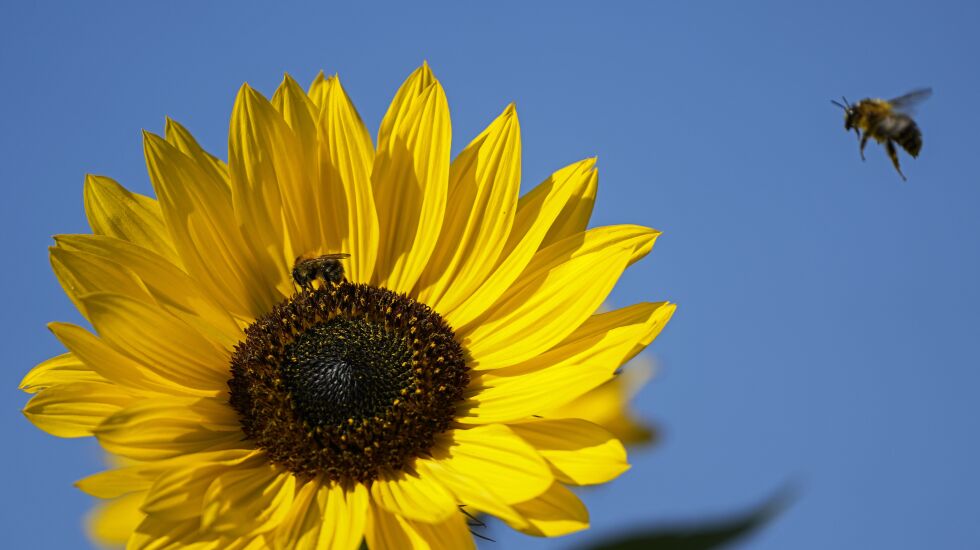
Endangered species in America from bees to birds can start breathing just a little bit easier.
Earlier this month, the U.S EPA took an important step toward protecting numerous endangered species from hazardous insecticides.
First, the technical stuff. The U.S. Environmental Protection Agency on June 16 said three “neonic” pesticides are likely to adversely affect from two-thirds to more than three-fourths of America’s endangered species — 1,225 to 1,445 species in all. The three neonicotinoid insecticides, also known as neonics, are clothianidin, imidacloprid and thiamethoxam.
Now it’s up to the federal government, along with the states, to build on that decision. If they do, it will help protect endangered species in the future and help make farming more sustainable in states such as Illinois with strong agricultural bases.
“[The EPA ruling] is good news. It is a call for action by the federal government and state governments,” Steve Blackledge, senior director of Environment America’s Conservation America Campaign, told us. “Neonics are causing a whole lot of harm.”
Neonics are effective pesticides that are applied in small doses directly to the surface of seeds. They add a much smaller amount of pesticides to the environment than widespread spraying.
But they are absorbed by plants, which makes the entire plant — including the plant’s nectar, pollen and fruit — deadly to some species, and they can linger in soil for years. Carried in runoff, neonics pollute waterways throughout the nation.
“It’s kind of scary how completely [neonics] took over field crop agriculture,” Bill Freese, scientific director of the Washington-based Center for Food Safety, told us.
Because neonics are so effective, sustainable organic farming practices such as crop rotation and planting off-season cover crops have tended to fall by the wayside, Freese said.
Neonics are banned in the European Union, but they are the most popular insecticides in the United States. The Illinois Public Interest Research Group has called for ending excessive use of the pesticides, including a ban on consumer use. Studies have showed neonics harm bees, birds, butterflies, freshwater invertebrates and mammals, according to the Center for Biological Diversity.
As Lori Ann Burd, the center’s environmental health director, said in a statement, “We’re in the midst of a heartbreaking extinction crisis, and neonicotinoids are playing an outsized role in driving it.”
Many species are struggling. The once-common American bumblebee has declined by about 89% in the past 20 years. A 2019 analysis found wild bird populations in the continental U.S. and Canada had declined by 29% — or about 3 billion birds — since 1970.
Among the species the EPA found were likely to be adversely affected by neonics are the Chinook salmon, Florida panther, Indiana bat, whooping crane, California red-legged frog, Karner blue butterfly and yellow larkspur, the Center for Food Safety said.
It’s not just a matter of losing endangered species. Illinois PIRG says bees pollinate 71 of the top 100 crops that provide 90% of the world’s food. Killing off damaging insects with pesticides doesn’t help as much as it should if plants don’t get pollinated.
Clearly, the threatened species need our help.
The next step in the process of regulating neonics is for the U.S. Fish and Wildlife Service and the National Marine Fisheries Service to draw up safeguards for the use of neonics based on the EPA’s ruling.
Over the past year, Massachusetts, Maine, New York and New Jersey have banned the consumer sale of neonics. In Illinois, state Rep. Will Guzzardi, D-Chicago, in January introduced a bill limiting the use of neonics on public lands, but the bill remained stuck in the Rules Committee when the session ended.
“The science is very clear [neonics] pose serious environmental threats,” Guzzardi said. “We have been working on this for a few years, but the chemical industry is dug in on this issue.”
Farmers need to be productive, especially at a time when food supplies have been disrupted worldwide. But that productivity should not come at the cost of unnecessarily harming many of our native species.
Want to write a letter to the editor or submit an op-ed for the Sun-Times? See our guidelines.







